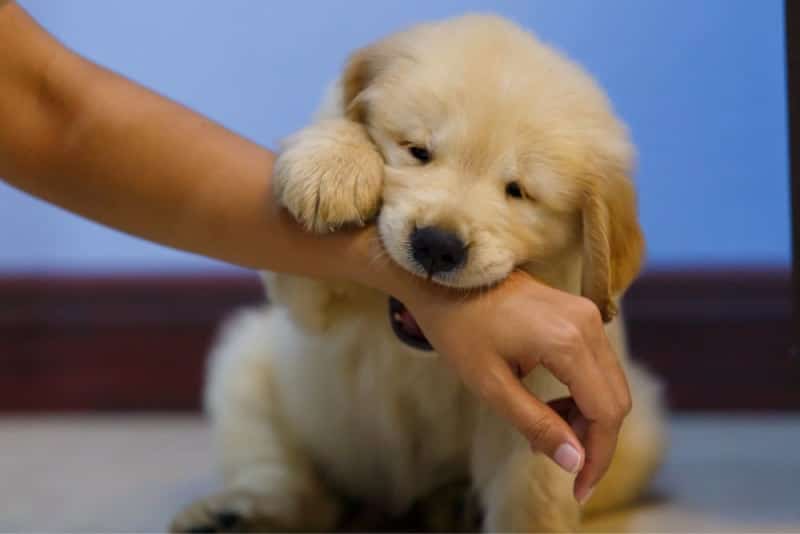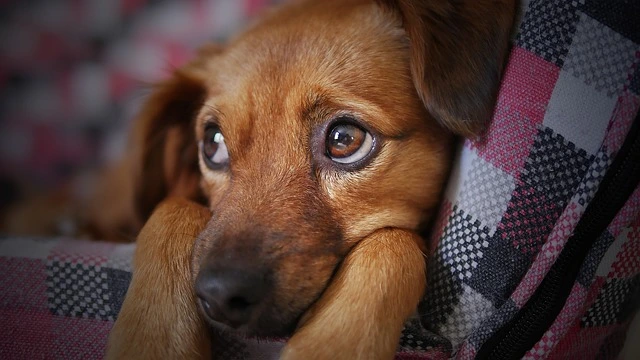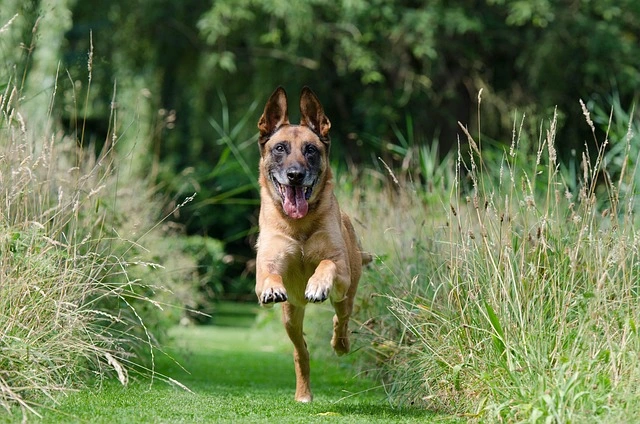You’ve bought every chew toy on Amazon, tried the “yelp method,” and even considered those bitter sprays, but your puppy still treats your hands like their personal chew toys. When you’ve exhausted Google searches for “my puppy won’t stop biting me i’ve tried everything,” it’s time for a fresh approach that actually addresses why puppies bite and how to redirect this natural behavior effectively.

Table of Contents
Quick Answer
Puppy biting is normal developmental behavior that typically peaks at 12-16 weeks and gradually decreases with consistent training. The most effective approach combines immediate redirection to appropriate toys, brief timeouts, and positive reinforcement when your puppy chooses correct items to chew.
TL;DR: Consistency beats intensity—redirect every bite to a toy, use brief timeouts, and reward good choices. Most puppies outgrow excessive biting by 6 months with proper guidance.
Why It Matters
Uncontrolled puppy biting isn’t just painful—it can escalate into resource guarding, aggressive play behaviors, and damaged relationships between family members and your growing dog. Young children are particularly vulnerable to scratches and fear development around the puppy.
Beyond immediate discomfort, puppies who don’t learn bite inhibition may struggle with appropriate mouth pressure throughout their lives. This affects their ability to take treats gently, play safely with other dogs, and respond appropriately during veterinary exams or grooming sessions.
Understanding Puppy Biting Development
Puppies explore their world through their mouths, just like human babies do with their hands. Between 3-6 months, puppies experience intense teething discomfort as 28 baby teeth are replaced by 42 adult teeth. This process creates a biological drive to chew and bite.
In normal litter development, puppies learn bite inhibition through play with siblings and mother corrections. When a puppy bites too hard, littermates yelp and stop playing, teaching natural consequences. Many puppies separated from litters before 8 weeks miss crucial bite inhibition lessons.
Puppies also use their mouths to initiate play, seek attention, and express excitement or frustration. Understanding these motivations helps you address the root cause rather than just the symptom.
Tools & Product Recommendations
KONG Classic Dog Toy
Perfect for teething puppies who need something substantial to chew. The hollow interior holds treats or peanut butter, keeping your puppy engaged for extended periods. Works best for medium to large breed puppies who can’t swallow it whole. The only limitation is that very small puppies might struggle with the size, so consider the puppy-specific version for breeds under 15 pounds.
Nylabone Puppy Chew Toy
Designed specifically for teething puppies with softer material that won’t damage developing teeth. The textured surface massages sore gums while satisfying the chewing instinct. Ideal for puppies 3-9 months who are actively teething. The main drawback is that aggressive chewers may destroy it quickly, requiring replacement.
Benebone Wishbone Flavored Chew Toy
Real flavoring makes this more appealing than plain rubber toys, and the unique shape allows puppies to grip it easily during chewing sessions. Best for puppies who ignore unflavored toys and need extra motivation to redirect biting behavior. The wishbone design can be awkward for very small breeds to manipulate effectively.
Rope Tug Toy with Knots
Cotton rope toys provide a different texture that many puppies prefer for interactive play and solo chewing. The fibers help clean teeth naturally, and the knots create varied textures. Works well for puppies who like to shake and “kill” their toys. Watch for loose threads that could create digestive issues if swallowed in large quantities.
Step-by-Step Tutorial
1. Create Your Redirection Arsenal Gather 4-5 different textured toys and keep them easily accessible in every room where your puppy spends time. Include soft plush, firm rubber, rope, and textured options to match your puppy’s preferences.
2. Master the Immediate Redirect The moment teeth touch skin, say “No” firmly and immediately offer an appropriate toy. Don’t delay—timing is crucial for puppies to make the connection between inappropriate and appropriate targets.
3. Use Brief Timeouts Strategically If your puppy continues biting after redirection, calmly remove them to a boring area for 30-60 seconds. This isn’t punishment—it’s removing the fun interaction that was reinforcing the biting behavior.
4. Reward Appropriate Chewing When your puppy chooses to chew their toys instead of you, offer praise and attention. Many owners accidentally ignore good behavior while only responding to problems.
5. Manage Energy Levels Overtired or overstimulated puppies bite more frequently. Schedule regular nap times and watch for early signs of fatigue like increased biting, zoomies, or inability to settle.
6. Practice Gentle Taking Teach your puppy to take treats softly by closing your fist around treats and only opening when they stop using teeth. This transfers to gentler interactions overall.
Training Methods: Quick Comparison
Positive Redirection
- Pros: Teaches appropriate behavior, builds positive associations, works with natural instincts
- Cons: Requires consistency from all family members, takes patience for results
- Best for: Most puppies, especially those who respond well to rewards
Time-Out Method
- Pros: Removes reinforcement for biting, gives puppy time to calm down, easy to implement
- Cons: Must be immediate to be effective, requires boring timeout space
- Best for: Attention-seeking puppies who escalate with redirection alone
Yelping Technique
- Pros: Mimics natural littermate feedback, easy for children to learn
- Cons: Can overstimulate some puppies, may not work for independent breeds
- Best for: Puppies who were well-socialized with littermates
Breed & Age Considerations
Small Breeds (Under 25 lbs) Toy breeds mature faster and may outgrow biting behavior by 4-5 months. Use smaller toys sized appropriately for their mouths. Avoid overly firm toys that could damage delicate teeth.
Medium Breeds (25-60 lbs) Most versatile in toy selection and training methods. Peak biting typically occurs around 14-16 weeks with gradual improvement through 6 months.
Large Breeds (60-90 lbs) Extended puppy period means biting may continue longer, but size makes training more urgent. Focus on extra-large toys they can’t swallow and prioritize gentle mouth training.
Giant Breeds (Over 90 lbs) Longest puppy development period with biting potentially lasting until 8-10 months. Early intervention is crucial due to size and strength. Emphasize calm interactions over high-energy play.
Common Mistakes (and Fixes)
- Playing rough with hands and feet. The fix: Only use toys for interactive play; keep hands for petting and treats.
- Inconsistent responses from family members. The fix: Create a family plan where everyone uses the same commands and redirection methods.
- Waiting too long to redirect. The fix: Interrupt biting the instant it starts; delayed responses confuse puppies.
- Using punishment-based methods. The fix: Focus on teaching what TO do rather than just stopping unwanted behavior.
- Ignoring the puppy when they chew appropriately. The fix: Make appropriate chewing more rewarding than biting through attention and praise.
- Allowing biting during “play” mode. The fix: End all interaction immediately when teeth contact skin, regardless of context.
- Not providing enough appropriate outlets. The fix: Ensure multiple chew options are always available and rotate them regularly.
Troubleshooting (If/Then)
If biting increases during evening hours, then implement a structured bedtime routine with calming activities.
If your puppy only bites certain family members, then have those individuals practice the most consistent redirection and positive interactions.
If redirection isn’t working, then evaluate whether you’re offering toys immediately enough and if the toys are appealing.
If biting seems aggressive rather than playful, then consult a professional trainer to rule out resource guarding or fear-based behaviors.
If your puppy bites when excited, then teach calm greetings and avoid high-energy interactions that trigger biting episodes.
When to See a Professional
Contact a certified dog trainer or veterinary behaviorist if your puppy shows these red flags: biting that breaks skin regularly, growling or stiff body language during biting episodes, biting that seems aggressive rather than playful, or no improvement after 4-6 weeks of consistent training.
Resource guarding around food, toys, or sleeping areas combined with biting requires immediate professional intervention. Similarly, if your puppy seems to target vulnerable family members like elderly individuals or young children specifically.
FAQs
How long does the puppy biting phase typically last?
Most puppies show significant improvement by 4-5 months with consistent training. Complete resolution usually occurs by 6-8 months as adult teeth fully emerge.
Is it normal for my puppy to bite harder when excited?
Yes, arousal increases bite intensity. Focus on keeping interactions calm and ending play sessions before your puppy becomes overstimulated.
Should I alpha roll or pin my puppy to stop biting?
No, dominance-based methods can increase aggression and damage your relationship. Positive redirection and management are more effective and safer.
Can I use bitter apple spray to stop biting?
Bitter sprays work better for inappropriate chewing than biting since puppies often bite for attention rather than taste preference.
My puppy only bites me, not other family members. Why?
You may inadvertently reward the behavior through your reaction, or your puppy may see you as their primary playmate. Ensure consistent responses across all interactions.
Is hand-feeding helpful for reducing biting?
Yes, hand-feeding teaches gentle mouth manners and builds positive associations with human hands. Always require gentle taking before releasing food.
What if my puppy bites during training sessions?
End the session immediately and redirect to a toy. Resume training only when your puppy is calm and focused on appropriate targets.
Conclusion
Remember that puppy biting is a normal developmental phase that requires patience and consistency rather than harsh corrections. The key lies in understanding why your puppy bites and providing appropriate outlets for this natural behavior while teaching bite inhibition through positive methods.
Your puppy isn’t being deliberately defiant—they’re learning crucial life skills about appropriate interaction with humans. With consistent redirection, appropriate outlets, and patient guidance, most puppies learn to control their bite within a few months.
Focus on setting your puppy up for success by managing their environment, energy levels, and interactions. The investment in proper training now prevents more serious behavioral issues later and builds a foundation for a lifelong bond based on mutual respect and understanding.
Stay consistent with your chosen methods, involve all family members in the training process, and don’t hesitate to seek professional help if you notice any concerning escalation. Your puppy’s biting phase will pass, and the effort you put in now will pay dividends throughout their adult life.
For additional support, consider connecting with local puppy socialization classes where your pup can learn appropriate play behavior from other well-supervised puppies.

